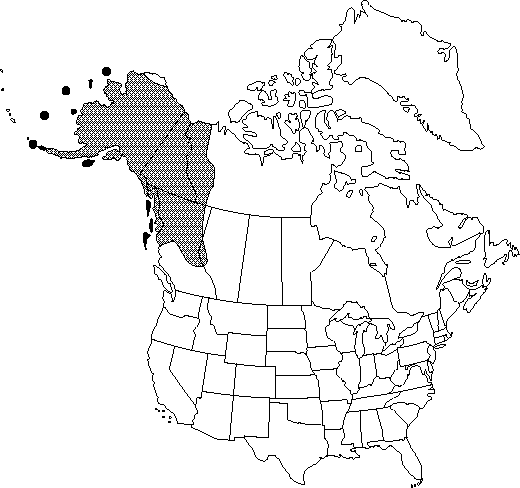Difference between revisions of "Aconitum delphiniifolium"
Syst. Nat. 1: 380. 1817.
FNA>Volume Importer |
FNA>Volume Importer |
(No difference)
| |
Revision as of 22:16, 16 December 2019
Roots tuberous, tuber ca. 10-15 × 5 mm, with 1 (rarely more) contiguous daughter tuber. Stem erect, slender, 1-10 dm. Cauline leaves: blade 3-divided to base, (1-)7(-13) cm wide, occasionally with up to 2(-4) mm of leaf tissue between deepest sinus and base of blade, 2 lateral segments each deeply 2-parted; margins cleft into narrow, linear-oblong lobes. Inflorescences open racemes or panicles. Flowers blue, purple, occasionally greenish purple, yellowish, or white, 20-40 mm from tips of pendent sepals to top of hood; pendent sepals 9-20 mm; hood low, crescent-shaped to hemispheric to conic-hemispheric, 10-24 mm high receptacle to top of hood, 13-30 mm broad from receptacle to beak apex. 2n=16.
Phenology: Flowering summer (mid Jun–Sep).
Habitat: Meadows, along creeks, thickets, woods, rocky slopes, and alpine tundra
Elevation: 0-1700 m
Distribution

Alta., B.C., N.W.T., Yukon, Alaska, Asia (Russia).
Discussion
Aconitum delphiniifolium is variable and was divided into three intergrading subspecies by E. Hultén (1941-1950, vol. 4) on basis of plant size, flower size, number of flowers, petal morphology, and narrow versus somewhat broader leaf lobing. Because of the "paucity of definitive criteria," J. A. Calder and R. L. Taylor (1968, vol.1) and S. L. Welsh (1974) chose not to recognize infraspecific taxa within A. delphiniifolium. Similarly, we have deferred formal recognition of infraspecific taxa within this species pending population studies. The most distinctive group within A. delphiniifolium has one to several large flowers with shallow nectaries borne on diminutive plants. These are sometimes distinguished as subsp. paradoxum, and they exhibit a different pattern of variation from that found in A. columbianum, in which large flower size is associated almost invariably with large, robust plants and deep nectaries.
More typical forms of Aconitum delphiniifolium are similar to A. columbianum except that leaves tend to be more deeply divided and the hood tends to be lower, i.e., more crescent-shaped and less conic. Some plants and populations of A. columbianum also have leaves divided almost to the base and low hoods. Intergradation between the two species should be investigated more fully.
The Salishan used Aconitum delphiniifolium for unspecified medicinal purposes (D. E. Moerman 1986).
Selected References
None.
